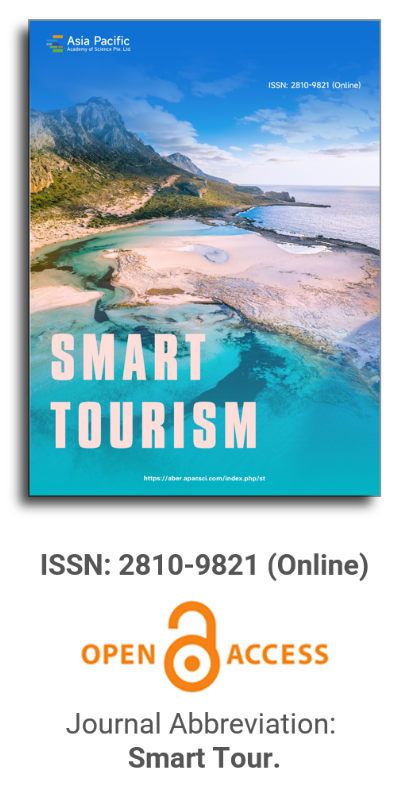


Research on spatial difference and dynamic mechanism of virtual tourism flow based on online group purchase
Vol 3, Issue 1, 2022
Download PDF
Abstract
Taking the online group purchase of tourism products as the research perspective and the online group purchase virtual tourism flow of tourism products in 26 tourism destinations in China as the research data, this paper studies the spatial distribution differences and formation dynamic mechanism of virtual tourism flow through the method of spatial analysis. On the whole, the online group purchase virtual tourism flow shows weak discrete distribution characteristics, and some parts show certain aggregation. The virtual passenger flow is concentrated in the provinces with rich tourism resources in the south coast and central China, and the group purchase virtual tourism flow in the central and western regions, North China and Northeast China is small. The spatial distribution of group purchase virtual tourism flow is the result of the joint action of internal and external driving forces and environmental driving forces. The external driving forces include three main driving factors: product group purchase price, product type and network marketing spatial structure. Relevant analysis shows that group purchase price is the most important external driving factor, followed by product type and finally network marketing spatial structure. Taking group buying virtual tourism flow as the research perspective has a certain novelty, which makes up for the weakness of tourism flow in virtual space. The flow direction of virtual tourism flow can reflect the real tourism flow to a certain extent, and even guide the real tourism flow. The research of virtual tourism flow provides a predictive warning for the flow management and capacity management of scenic spots.
Keywords
References
- Kauffman RJ, Wang B. New buyers’ arrival under dynamic pricing market microstructure: The case of group buying discounts on the Internet. Journal of Management Information System 2001; 18(2): 157–188.
- Peng L, Li N. FAHP based evaluation of the group buying website. 2011 8th International Con-ference on Service Systems and Service Manage-ment. New York: Institute of Electrical and Elec-tronics Engineers Inc.; 2011.
- Sun P, Luo J, Liu Y. Perceived risk and trust in online group buying context. 2010 International Confer-ence on Information Management, Innovation Management and Industrial Engineering (ICIII). New York: Institute of Electrical and Electronics Engineers Inc.; 2010.
- Yang P. Analysis of network group purchase. Mall Modernization 2011; (6): 69–70.
- Fei X. Research on online group buying based on game theory. Contemporary Economy 2011; (7): 110–112.
- Song Y. Research on online group purchase mode based on B2C [Master’s thesis]. Shanghai: Central China Normal University; 2007.
- Wang L. On the network marketing strategy of lei-sure tourism products. Market Forum 2011; (2): 75–76.
- Wang L. Case study of tourism group buying web-site based on SWOT analysis. Inner Mongolia Sci-ence and Technology and Economy 2011; (20): 15–16.
- Shan H. Risk evaluation of online group buying tourism products and analysis of risk avoidance countermeasures. Modern Marketing 2011; (12): 200–201.
- Chen S. Analysis on the new path of tourism network marketing—Tourism group purchase. Journal of Lanzhou Institute of education 2011; (4): 41–43.
- Niu Y. Research on the spatial relationship between tourism supply and demand. Journal of Geography 1996; 51(1): 80–87.
- Mansfield Y. Spatial pattern of international tourist flows: Towards a theoretical framework. Progress in Human Geography 1990; 14(3): 372–390.
- Lu L. A study on the spatial behavior of tourists in mountain scenic spots: A comparison between Huangshan and Yellowstone Park in the United States. Journal of Geography 1996; 51(4): 315–321.
- Mathieson A, Wall G. Tourism: Economic, physical and social impacts. Harlow: Longman; 1982.
- Zhang J, Du J, Zhou Y, et al. Study on the spatial structure of tourist source market in natural tourism destination. Journal of Geography 1999; 54(4): 357–369.
- Getis A, Ord JK. The analysis of spatial associa-tion by use of distance statistics. Geographical Analysis 1992; 24(3): 189–240.
- Wu Y. Spatial econometric research on Regional R & D, knowledge spillover and innovation in China. Beijing: People’s Publishing House; 2007.
- Wu Y, Xu J. Spatial statistical analysis of regional economic growth agglomeration in China. Geosci-ence 2004; 24(6): 654–659.
- Anselin L. Local indicators of spatial associa-tion-LISA. Geographical Analysis 1995; 27(2): 93–115.
- Long M, Sun G, Ma L, et al. Comparative analysis of temporal and spatial dynamics of regional tourism network attention and passenger flow—A case study of Sichuan. Regional Research and Development 2011; 30(3): 93–97.
Supporting Agencies
Copyright (c) 2022 Wei Tu, Zhenfang Huang, Yelin Fang
License URL: https://creativecommons.org/licenses/by/4.0/

This site is licensed under a Creative Commons Attribution 4.0 International License (CC BY 4.0).

Prof. Hung-Che Wu
Nanfang College, Guangzhou
China
Indexing & Archiving
Asia Pacific Academy of Science Pte. Ltd. (APACSCI) specializes in international journal publishing. APACSCI adopts the open access publishing model and provides an important communication bridge for academic groups whose interest fields include engineering, technology, medicine, computer, mathematics, agriculture and forestry, and environment.



.jpg)
.jpg)

.jpg)

